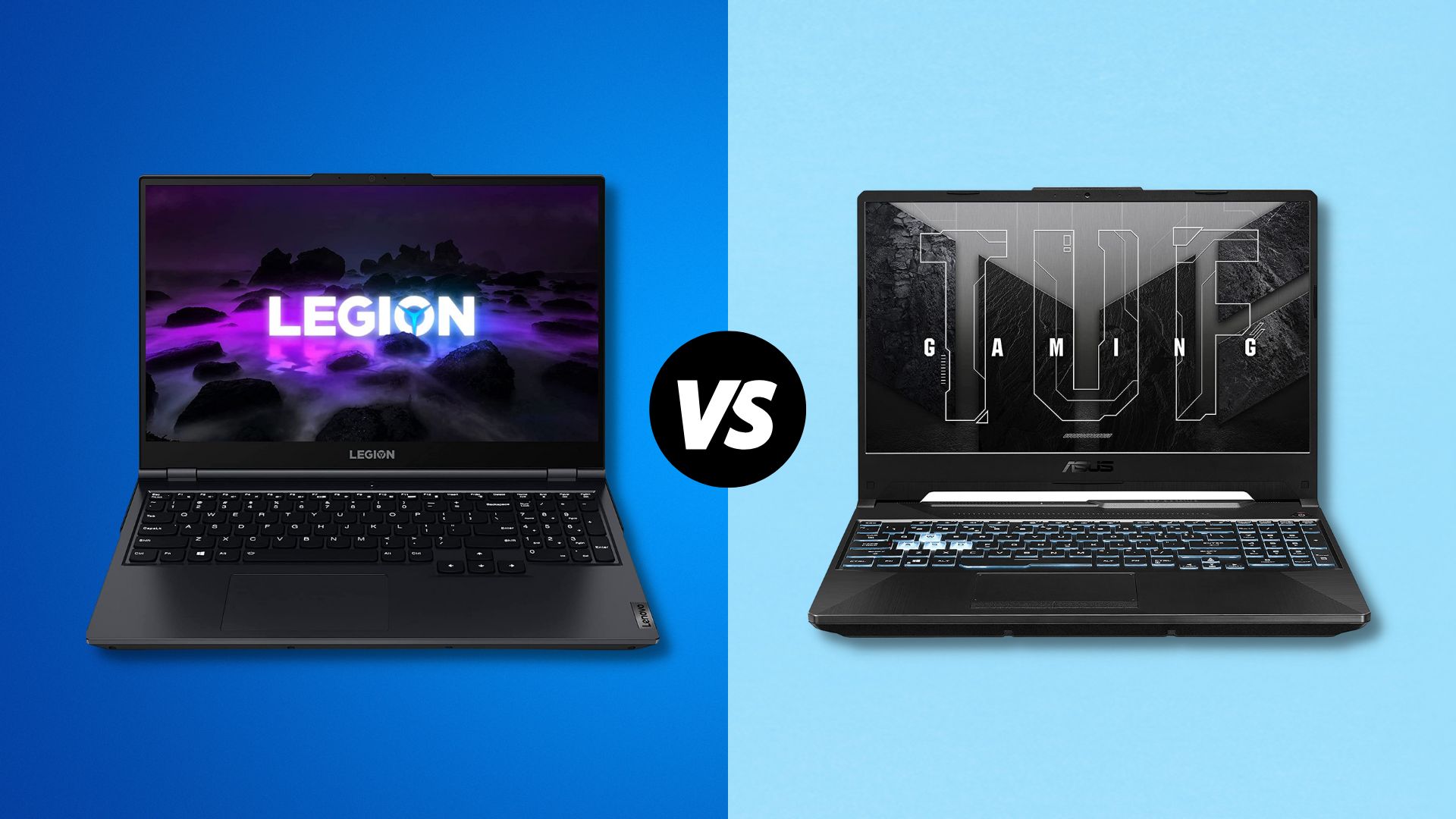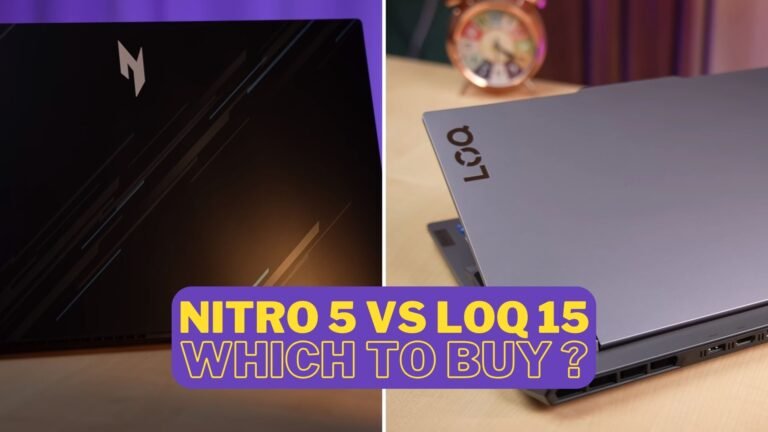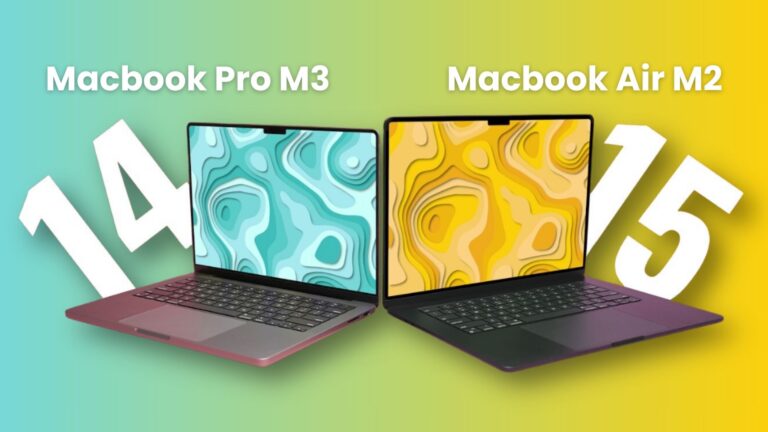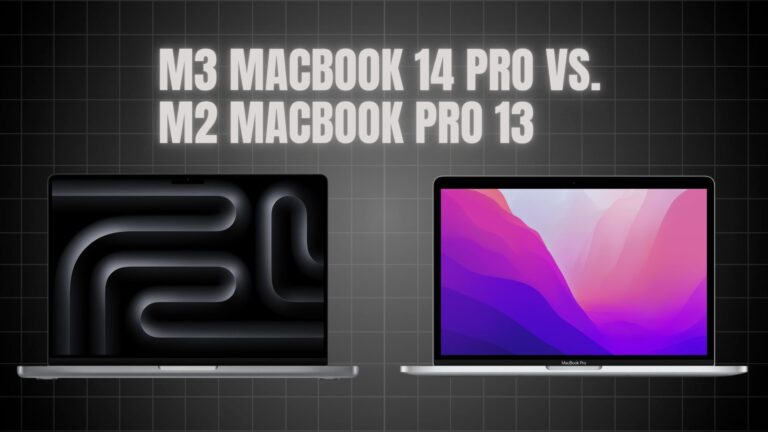Lenovo’s Legion 5 and ASUS’s TUF A15 are both great mid-range gaming laptops this year, but which should you get?
| Lenovo Legion 5 | ASUS TUF A15 |
 |  |
| Check Price | Check Price |
| Lenovo Legion 5 Review | Asus TUF A15 Review |
Legion 5 vs TUF A15: Specs
| Lenovo Legion 5 | ASUS TUF A15 | |
| CPU | RYZEN 7 6800H | RYZEN 7 6800H |
| GPU | RTX 3060 | RTX 3060 |
| RAM | 16GB DDR5 | 16GB DDR5 |
| DISPLAY | 15.6″ 1440P 165HZ | 15.6″ 1080P 144HZ |
| STORAGE | 512GB NVME M.2 SSD | 512GB NVME M.2 SSD |
| BATTERY | 80WH | 4-CELL 90WH |
Legion 5 vs TUF A15: Design
Both laptops have decent build quality, with nice-feeling plastic interiors and metal lids on each. The keyboards and lid only slightly flex, which is acceptable for mid-range gaming laptops. The Legion 5 wasn’t just bigger; it was also noticeably heavier. In some areas, the Legion is also offered with a 300-watt power brick, which would add even more weight.
Legion 5 vs TUF A15: Display
Although both laptops have a 15.6” screen, they’re both available with 1080p or 1440p options. The Legion gets brighter at full brightness, but at 90% brightness or below the TUF was brighter. The color gamut was much better with the Legion, and TUF just doesn’t seem that great.
Both laptops have a MUX switch, only the Legion takes things to the next level with advanced Optimus, meaning you don’t have to reboot to swap between Optimus on or off. The TUF would need a manual reboot to change.
Legion 5 vs TUF A15: IO and Ports
| ASUS TUF A15 | Lenovo Legion 5 |
| 1x 3.5mm Combo Audio Jack 1x HDMI 2.0b 1x USB 3.2 Gen 1 Type-C 2x USB 3.2 Gen 1 Type-A 1x RJ45 LAN port 1x USB 3.2 Gen 1 Type-C support DisplayPort™ / G-SYNC | 1x power connector 1x USB-C 3.2 Gen 2 (support data transfer, Power Delivery and DisplayPort™ 1.4) 1x Ethernet (RJ-45) 1x USB-C 3.2 Gen 2 (support data transfer and DisplayPort 1.4) 1x headphone / microphone combo jack (3.5mm) 1x HDMI® 2.1 4x USB 3.2 Gen 1 (one Always On) |
For me, the port layout on the Legion is better because it keeps cables like the ethernet and power running out the back and out of the way. Additionally, the ports on the Legion are simply superior.
The Legion has three USB Type-A ports compared to the TUF’s two. Additionally, the Legion has three USB Type-C ports compared to the TUF’s two, and the Legion’s faster USB 3.2 Gen 2 ports than the TUF’s slower Gen 1 ports.
The Type-C port on the back of the Legion can be used to charge the laptop with up to 130 watts, in contrast to the TUF’s lack of Type-C charging. Only one of the Type-C ports on the TUF can be used to connect an external screen with DisplayPort, while all three of the Type-C ports on the Legion support that. The TUF can only connect a 4K 60Hz 8-bit screen with G-Sync, whereas the Legion has HDMI 2.1 and can connect a 4K 120Hz 8-bit screen with G-Sync.
Legion 5 vs TUF A15: Speakers
Both laptops have speakers on the bottom, towards the front, on the left and right sides. The speakers on the Legion have a clearer, but the TUF sounds better to me overall because it has more bass.
Legion 5 vs TUF A15: Keyboard & Touchpad
Because the keys on the Legion keyboard felt clickier and more pleasant to press, I preferred using it. The TUF has clear WASD keys that make it more obvious that it is a gaming laptop, whereas the Legion has larger and easier-to-press arrow keys.
Although the key brightness was slightly higher on the TUF, compared to the consistently lit Legion keys, the TUF’s lighting appeared a little more patchy. Both keyboards have a single zone of RGB backlighting.
Both of the touchpads worked well. The clicker feel with the Legion was better in my opinion, but the TUF’s was about a centimeter wider and still functioned satisfactorily.
Legion 5 vs TUF A15: Gaming Performance

The game benchmark for Red Dead Redemption 2 was used for testing, and at 1080p the Legion 5 was just 1 FPS faster, which is a negligible difference and falls within the margin of error. In any case, it won’t be a change that you’ll notice while playing. Moving up to the higher 1440p resolution the Legion has a slight advantage, but again, there was only a 1 FPS difference, so there was no significant improvement in either direction.

At 1080p and the higher 1440p resolutions, Cyberpunk 2077 had a slight FPS advantage over the Legion 5, though the A15 was still slightly behind. However, the average FPS difference is now even smaller.

At 1080p, the TUF A15 edged out the Legion by about 1 frames per second. At the higher resolution of 1440p, the TUF again edged out the Legion by about 2 frames per second.
Legion 5 vs TUF A15: Battery Life
In the YouTube video playback test with both screens set to 200 nits, the TUF’s battery lasts 19% longer than the Legion’s despite being 12.5% bigger. The Legion, on the other hand, lasted a little longer when playing a game.
Legion 5 vs TUF A15: Conclusion
The ASUS TUF A15 seems to be cheaper compared to Lenovo’s Legion 5. So then the question becomes: is it worth paying more money to get the Legion 5? Honestly, probably not. In more cases than not, the TUF A15 was the better laptop. Things like performance in games were tied. And the TUF also lasts longer when running off of the battery, at least when not gaming. The TUF did run hotter, but this isn’t something I’d personally be worried about.
The TUF is a little smaller and more portable as it’s a fair bit lighter too, and its speakers sound better too.
The Legion does have some nice extras though, including more and better ports, and in my opinion a better keyboard and touchpad. Build quality was fairly evenly matched.
All things considered though, unless you need the extra or faster ports of the Legion, or if you’re lazy and you want advanced optimus so you don’t have to reboot to turn optimus on or off, then you really can just save the money and get the cheaper TUF A15 in most cases.






